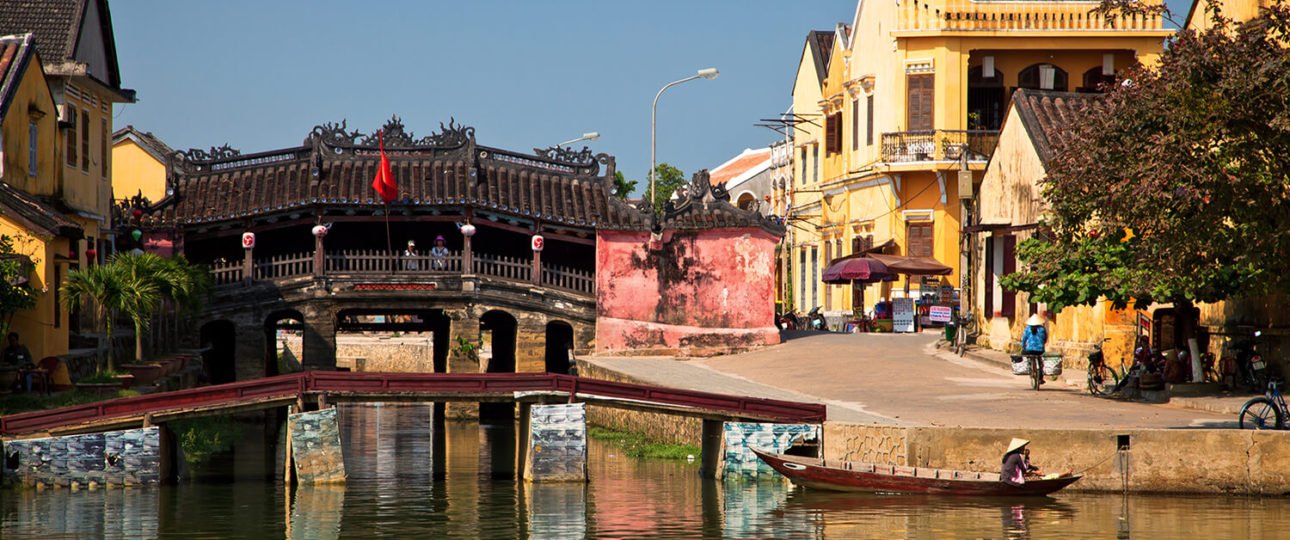Meaning of Hoi An: Peaceful meeting place
Hoi An Ancient Town is an exceptionally well-preserved example of a South-East Asian trading port dating from the 15th to the 19th century. Its buildings and street plan reflect the influences, both indigenous and foreign, that have combined to produce this unique UNESCO world heritage site.
If Halong Bay is the most scenic in S.E. Asia then Hoi An along with Luang Prabang in Laos can lay claim to the most Charming. And as good as it gets anywhere on earth even.
Hoi An Today
The town today comprises a well-preserved complex of 1,107 timber frame buildings, with brick or wooden walls, which include architectural monuments, commercial and domestic vernacular structures, notably an open market and a ferry quay, and religious buildings such as pagodas and family cult houses.
The houses are tiled and the wooden components are carved with traditional motifs. They are arranged side-by-side in tight, unbroken rows along narrow pedestrian streets.
There is also the fine wooden Japanese bridge, with a pagoda on it, dating from the 18th century.
The original street plan, which developed as the town became a port, remains. It comprises a grid of streets with one axis parallel to the river and the other axis of streets and alleys set at right angles to it. Typically, the buildings front the streets for convenient customer access while the backs of the buildings open to the river allowing easy loading and off-loading of goods from boat
The surviving wooden structures and street plan are original and intact and together present a traditional townscape of the 17th and 18th centuries, the survival of which is unique in the region.
The town continues to this day to be occupied and function as a trading port and centre of commerce. The living heritage reflecting the diverse communities of the indigenous inhabitants of the town, as well as foreigners, has also been preserved and continues to be passed on. Hoi An Ancient Town remains an exceptionally well-preserved example of a Far Eastern port.
Hoi An Ancient Town has retained its original form and function as an outstanding example of a well-preserved traditional S. E. Asian trading port and commercial centre.
It remains complete as a homogenous complex of traditional wooden buildings, with the original organically developed street plan, within the town’s original river/seacoast setting.
Hoi An Tourism
As you can read above it is still the same today and cars are not allowed either. This retains the charm and makes strolling a joy.
Shops and accommodation for tourism have been tastefully blended in to retain the aura. A not to be missed highlight for all travellers.
Again, it will not get any more laid back than having a pre-dinner drink in the Bamboo restaurant or one of the many other idyllic spots. A Banana flower salad for dinner perhaps or one of Hoi An’s own speciality dishes.
You are not a traveller if Hoi An is not on your list of must-sees. Hoi An is a real-life history lesson.
Lastly, buy yourself a new tailor-made suit at a fraction of the price back home as the Hoi An quality is now famous. Or just shop for wonderful arts and crafts & other souvenirs as you stroll around taking in all the atmosphere, which is the real highlight you get free of charge
Book the following tour and visit Hoi An along with most of the other super highlights in Vietnam, Cambodia & Laos.
Tick off all of the must-sees in a single 4 week highlights holiday. Get there quick before they become like the over touristed European highlights of today. They are big already and will only get bigger as word gets out.
Check Out Tour 33 – Indochina Highlights: Small Group Soft Adventure Tour – 30 Days
Source: https://whc.unesco.org/en/list/948/#targetText=Hoi%20An%20Ancient%20Town,produce%20this%20unique%20heritage%20site




